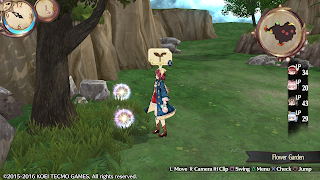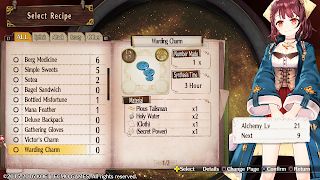Atelier Sophie Review: Occult Recipes And Dolls
The local alchemist of Kirchen Bell, Sophie, makes ends meet by creating various things for the townspeople. She was taught the art of alchemy by her now deceased grandmother, but only learned the basics before her mentor passed away. Trying and failing to make any improvement in her abilities, Sophie proceeds to fill in the blank pages of an alchemical recipe book when it suddenly springs to life. Formally an alchemist called Plachta, the book is suffering from amnesia and only by filling out her pages with new recipes can she reclaim her lost memories. Sophie promises to help Plachta regain her memories and eventually return her to her human form.
Gameplay is split between field activities (gathering ingredients, fighting monsters) and socializing or synthesizing new items at the Atelier (Sophie's home). As Sophie fulfills town requests or explores the wilderness areas, she will conjure up new recipe ideas. These in turn fill out Plachta's pages, unlocking new memories that push the story forward.
Town requests are either: collect X number of items or slay X number of monsters. They are rather mundane tasks that have the player returning to the same handful of small areas again and again. The game world also runs on a 5 day week consisting of Sprout, Bud, Flower, Fruit, and Seed. Fruit and Seed are the weekend. There is no time management or deadline to meet despite the presence of a clock and calendar. It only effects which enemies or collectable materials will appear.
Alchemy is the bread and butter of the Atelier series, and Sophie puts an especially heavy emphasis on this mechanic. It uses a simple grid-like puzzle system of synthesizing new items. Recipes require items from up to five different categories, and 1 to 3 items (depending on the difficulty) from each category. Every item has a size, a number, and a color. During synthesis there will be up to three "effects" listed in different colors, that can be activated by meeting or exceeding their numerical threshold. The number and color of a material determines how much it adds to the "effect" of the same color. The size determines the number of blocks and shape that the material will occupy on the grid.
Left: Selecting a recipe. Right: Picking out ingredients based on their value.
At the top of the grid are five colored orbs: red, blue, green, yellow, and white. Placing materials of the same color on the grid will increase the percentage number of that specific orb. The percentage number next to these orbs adds a bonus value to the "effect" of the same color. There are also glowing stars on randomly selected sections of the grid. Placing materials on the grid will generate additional stars around the placed materials. The stars can stack up to 3 times, gradually increasing in size. These glowing stars add a bonus to the material placed upon them, so saving the material you want the greatest effect on for last is ideal. Materials can be placed on top of one another, but doing so causes you to lose the color percentage of the material that was "pushed down". The final quality of the synthesized item is determined by the quality of the materials used and how much of the grid was covered; more is better.
The battle system is pretty intuitive, if not a little basic. Characters can be equipped with defensive, offensive, and consumable items that Sophie makes in her atelier. At the start of combat you get a rough indication of what the enemy will do during their turn: Attack (regular attack), Warning (powerful attack), or Break (The enemy won't attack this turn). You then get to decide what each of your party members will do that turn. Each character can also choose between an "Aggressive" or "Defensive" stance. The stance determines if the character will perform an additional attack or guard other party members when the "Chain Counter" reaches 100% or more. The player's round will only commence once an action has been chosen for every party member.
Despite the cast being made up of friends living in the same town, and going into battle together, there is surprisingly minimal character development. Key characters have a friendship level that increases either by having them in the active party during combat, or by giving them gifts whenever you see them around town. Every character has their own likes and dislikes, which will influence not only the rate at which their friendship level grows, but also the gifts they bring to Sophie in return. Story progression is also tied into some special friendship level related cutscenes and exploration events.
The removal of time limits, coupled with the new crafting/idea-based progression blocks in the story, made Atelier Sophie a slog to get through; I almost fell asleep on more than one occasion while playing. Progression of any kind was slow and monotonous, and while the series isn't known for impressive storytelling, I found the narrative in Sophie to be especially thin. The synthesizing can be fun, but the tedious gameplay loop and surrounding elements are not nearly as engaging. Veterans to the series won't miss out on much by skipping this entry entirely. New comers are better off picking up the next title in the "Mysterious" sub-series - Atelier Firis: The Alchemist and the Mysterious Journey.
First posted to videogamegeek.com on July 9, 2020.
Related Reviews:




















Comments
Post a Comment